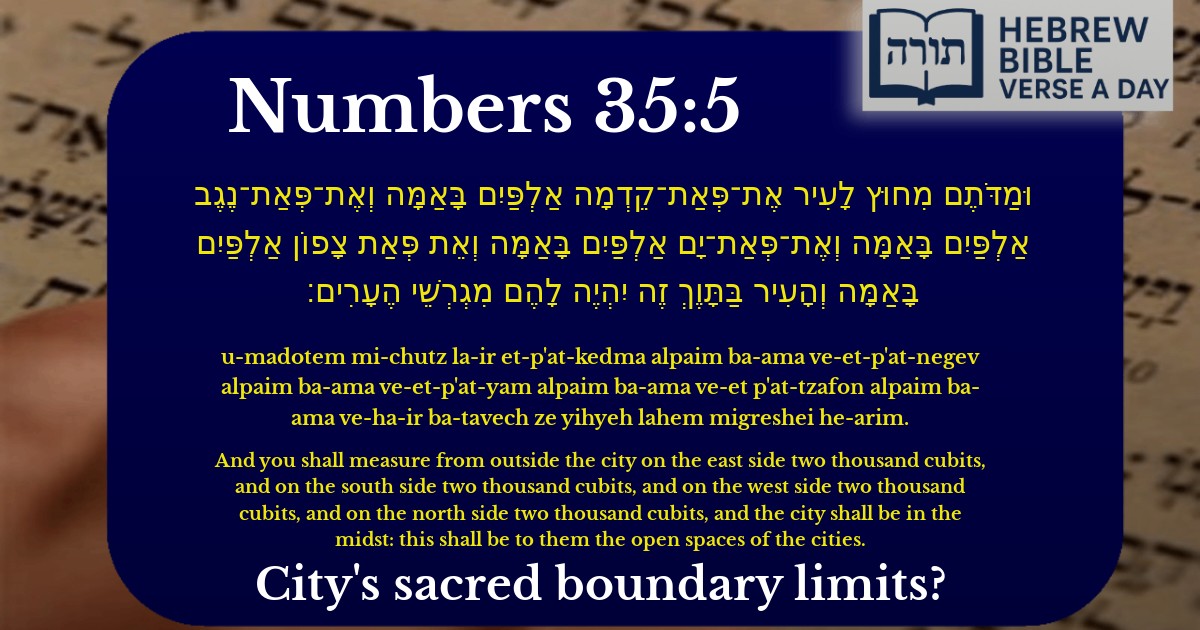Join Our Newsletter To Be Informed When New Videos Are Posted
Join the thousands of fellow Studends who rely on our videos to learn how to read the bible in Hebrew for free!
Hebrew Text
וּמַדֹּתֶם מִחוּץ לָעִיר אֶת־פְּאַת־קֵדְמָה אַלְפַּיִם בָּאַמָּה וְאֶת־פְּאַת־נֶגֶב אַלְפַּיִם בָּאַמָּה וְאֶת־פְּאַת־יָם אַלְפַּיִם בָּאַמָּה וְאֵת פְּאַת צָפוֹן אַלְפַּיִם בָּאַמָּה וְהָעִיר בַּתָּוֶךְ זֶה יִהְיֶה לָהֶם מִגְרְשֵׁי הֶעָרִים׃
English Translation
And you shall measure from outside the city on the east side two thousand cubits, and on the south side two thousand cubits, and on the west side two thousand cubits, and on the north side two thousand cubits, and the city shall be in the midst: this shall be to them the open spaces of the cities.
Transliteration
U-madotem mi-chutz la-ir et-p'at-kedma alpaim ba-ama ve-et-p'at-negev alpaim ba-ama ve-et-p'at-yam alpaim ba-ama ve-et p'at-tzafon alpaim ba-ama ve-ha-ir ba-tavech ze yihyeh lahem migreshei he-arim.
Hebrew Leining Text
וּמַדֹּתֶ֞ם מִח֣וּץ לָעִ֗יר אֶת־פְּאַת־קֵ֣דְמָה אַלְפַּ֪יִם בָּֽאַמָּ֟ה וְאֶת־פְּאַת־נֶ֩גֶב֩ אַלְפַּ֨יִם בָּאַמָּ֜ה וְאֶת־פְּאַת־יָ֣ם ׀ אַלְפַּ֣יִם בָּֽאַמָּ֗ה וְאֵ֨ת פְּאַ֥ת צָפ֛וֹן אַלְפַּ֥יִם בָּאַמָּ֖ה וְהָעִ֣יר בַּתָּ֑וֶךְ זֶ֚ה יִהְיֶ֣ה לָהֶ֔ם מִגְרְשֵׁ֖י הֶעָרִֽים׃
Parasha Commentary
📚 Talmud Citations
This verse is quoted in the Talmud.
📖 Sotah 27b
The verse is referenced in a discussion about the measurements of the open spaces around cities, particularly in relation to the laws of the Levitical cities and their suburbs.
📖 Bava Batra 61b
The verse is cited in a discussion about the dimensions and boundaries of cities, especially concerning the allocation of land and the concept of 'migrashim' (open spaces).


Overview of the Verse
The verse (Bamidbar 35:5) discusses the requirement to designate migrashim (open spaces) around the cities of the Levites. These areas served as buffer zones, ensuring that the cities remained holy and separate from agricultural or commercial activities. The measurement of 2,000 cubits (approximately 3,000 feet) in each direction emphasizes the importance of maintaining sanctity and order around these cities.
Rashi's Explanation
Rashi (Bamidbar 35:5) explains that the migrashim were not for residential or agricultural use but were left empty to enhance the beauty and dignity of the Levite cities. He notes that these open spaces were distinct from the "suburbs" (kerachim) mentioned earlier (Bamidbar 35:3), which were only 1,000 cubits wide. The additional 1,000 cubits here served as a further boundary to prevent encroachment.
Rambam's Perspective
In Hilchot Shemittah v’Yovel (13:5), Rambam elaborates that the migrashim were inviolable spaces where planting, plowing, or building was prohibited. This reinforced the Levites' unique role as spiritual leaders, as their cities were to remain free from mundane distractions. The symmetrical measurement (2,000 cubits in all directions) symbolizes balance and fairness in allocating sacred space.
Talmudic and Midrashic Insights
Symbolism and Practical Application
The verse underscores the Torah’s emphasis on creating boundaries between the sacred and the mundane. The Levites, who served in the Mishkan and later the Beit HaMikdash, needed their surroundings to reflect their spiritual mission. The uniform measurement in all directions also teaches that holiness must be preserved equally, without favoritism or neglect in any aspect of life.